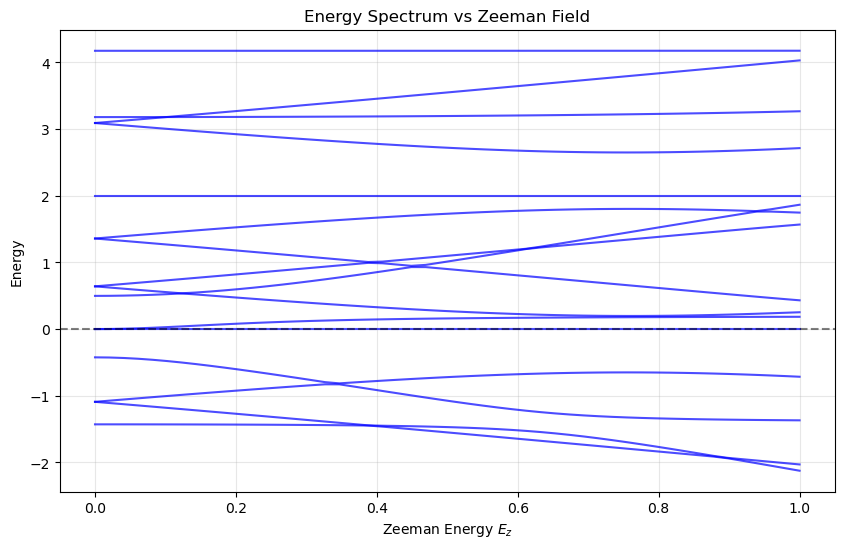Tutorial#
Welcome to the second_quantization package tutorial! This section contains comprehensive examples demonstrating all the functionality of the package through practical physics applications.
Tutorial Overview#
This tutorial consists of three main examples:
Poor Man’s Majorana Model (this page): A comprehensive example showing symbolic operator algebra, Hamiltonian construction, and spectroscopic analysis
Parametric Many-Body Model: Basic usage patterns and simple models
Quantum Dot Analysis: Advanced features with realistic condensed matter applications
Examples#
Poor Man’s Majorana Model#
Overview#
The “poor man’s Majorana” model describes a simplified system that can host Majorana-like modes using conventional superconducting quantum dots. This tutorial demonstrates how to use the second_quantization package to:
Define symbolic fermionic operators
Construct complex many-body Hamiltonians
Convert symbolic expressions to numerical matrices
Analyze quantum many-body systems
System Description#
We consider a minimal model with two quantum dots (left and right) coupled through a superconducting pairing mechanism. Each dot can host electrons with spin up (↑) and spin down (↓), leading to a four-dimensional single-particle Hilbert space.
Setting Up the Problem#
First, let’s import the necessary libraries and define our system parameters:
import numpy as np
import sympy
from sympy.physics.quantum.fermion import FermionOp
from sympy.physics.quantum import Dagger
from sympy.physics.quantum.operatorordering import normal_ordered_form
import matplotlib.pyplot as plt
# Define operator names for clarity
operator_names = [
'c_{L,\\uparrow}', 'c_{L,\\downarrow}',
'c_{R,\\uparrow}', 'c_{R,\\downarrow}'
]
# Define physical parameters as symbolic variables
t, theta, Delta, mu_L, mu_R, U, E_z = sympy.symbols(
"t, theta, Delta, mu_L, mu_R, U, E_z",
real=True, commutative=True
)
Now let’s create the fermionic operators for our two-dot system:
# Create fermionic operators for each site and spin
fermions = [FermionOp(name) for name in operator_names]
c_Lu, c_Ld, c_Ru, c_Rd = fermions
print("Fermionic operators created:")
for op, name in zip(fermions, operator_names):
print(f" {name}: {op}")
Fermionic operators created:
c_{L,\uparrow}: c_{L,\uparrow}
c_{L,\downarrow}: c_{L,\downarrow}
c_{R,\uparrow}: c_{R,\uparrow}
c_{R,\downarrow}: c_{R,\downarrow}
Building the Hamiltonian#
The poor man’s Majorana Hamiltonian consists of several physical terms. Let’s construct each term systematically and understand their physical meaning.
1. Onsite Energies#
The onsite energy term describes the chemical potential of electrons on each dot:
# Onsite energies (chemical potentials)
onsite = mu_L * (Dagger(c_Lu) * c_Lu + Dagger(c_Ld) * c_Ld)
onsite += mu_R * (Dagger(c_Ru) * c_Ru + Dagger(c_Rd) * c_Rd)
print("Onsite energy term:")
display(onsite)
Onsite energy term:
This term allows us to control the occupancy of each dot independently.
2. Inter-dot Hopping#
The hopping term couples the two dots through spin-dependent tunneling:
# Hopping between dots with spin-orbit coupling
hopping = t * sympy.cos(theta/2) * (Dagger(c_Lu) * c_Ru + Dagger(c_Ld) * c_Rd)
hopping += t * sympy.sin(theta/2) * (Dagger(c_Ld) * c_Ru - Dagger(c_Lu) * c_Rd)
print("Hopping term:")
display(hopping)
print("\nHermitian conjugate:")
display(Dagger(hopping))
Hopping term:
Hermitian conjugate:
The parameter \(\\theta\) controls the strength of spin-orbit coupling in the tunneling.
3. Superconducting Pairing#
The pairing term creates Cooper pairs across the two dots:
# Superconducting pairing term
pairing = Delta * sympy.cos(theta/2) * (-Dagger(c_Lu) * Dagger(c_Rd) + Dagger(c_Ld) * Dagger(c_Ru))
pairing += Delta * sympy.sin(theta/2) * (Dagger(c_Lu) * Dagger(c_Ru) + Dagger(c_Ld) * Dagger(c_Rd))
print("Superconducting pairing term:")
display(pairing)
print("\nHermitian conjugate:")
display(Dagger(pairing))
Superconducting pairing term:
Hermitian conjugate:
This term enables the formation of Andreev bound states between the dots.
4. Zeeman Splitting#
The Zeeman term splits spin-up and spin-down states in an external magnetic field:
# Zeeman splitting in magnetic field
zeeman = E_z * (Dagger(c_Lu) * c_Lu - Dagger(c_Ld) * c_Ld)
zeeman += E_z * (Dagger(c_Ru) * c_Ru - Dagger(c_Rd) * c_Rd)
print("Zeeman splitting term:")
display(zeeman)
Zeeman splitting term:
5. Coulomb Interaction#
The Coulomb interaction penalizes double occupancy on each dot:
# Coulomb interaction (double occupancy penalty)
coulomb = U * (Dagger(c_Lu) * c_Lu * Dagger(c_Ld) * c_Ld)
coulomb += U * (Dagger(c_Ru) * c_Ru * Dagger(c_Rd) * c_Rd)
print("Coulomb interaction term:")
display(coulomb)
Coulomb interaction term:
6. Complete Hamiltonian#
Now we assemble the complete Hamiltonian and put it in normal-ordered form:
# Assemble the complete Hamiltonian
H = onsite + zeeman + hopping + Dagger(hopping) + pairing + Dagger(pairing) + coulomb
# Convert to normal-ordered form for easier manipulation
H = normal_ordered_form(H.expand(), independent=True)
print("Complete Hamiltonian assembled and normal-ordered")
print(f"Number of terms: {len(H.args) if hasattr(H, 'args') else 1}")
Complete Hamiltonian assembled and normal-ordered
Number of terms: 26
Numerical Analysis with second_quantization#
Now we’ll convert our symbolic Hamiltonian to a numerical matrix representation using the second_quantization package.
Converting to Matrix Form#
from second_quantization import hilbert_space
# Convert the symbolic Hamiltonian to matrix representation
print("Converting symbolic operators to matrix form...")
H_matrix_terms = hilbert_space.to_matrix(expression=H, operators=fermions, sparse=False)
# Create a callable function for easy parameter substitution
H_function = hilbert_space.make_dict_callable(H_matrix_terms)
# Get information about the basis
basis_ops = hilbert_space.basis_operators(fermions, sparse=False)
print(f"Hilbert space dimension: {len(basis_ops)}")
print(f"Basis states: {len(basis_ops)} Fock states")
Converting symbolic operators to matrix form...
Hilbert space dimension: 4
Basis states: 4 Fock states
Setting Physical Parameters#
Let’s define realistic parameter values for our quantum dot system:
# Define system parameters (energies in units of the hopping t)
parameters = {
't': 1.0, # Hopping energy (reference scale)
'Delta': 0.5, # Superconducting gap
'theta': np.pi/4, # Spin-orbit coupling angle
'mu_L': 0.0, # Left dot chemical potential
'mu_R': 0.0, # Right dot chemical potential
'U': 2.0, # Coulomb interaction strength
'E_z': 0.3 # Zeeman energy
}
print("System parameters:")
for param, value in parameters.items():
print(f" {param}: {value}")
System parameters:
t: 1.0
Delta: 0.5
theta: 0.7853981633974483
mu_L: 0.0
mu_R: 0.0
U: 2.0
E_z: 0.3
Computing the Spectrum#
# Evaluate the Hamiltonian matrix with our parameters
H_matrix = H_function(**parameters)
# Compute eigenvalues and eigenvectors
eigenvalues, eigenvectors = np.linalg.eigh(H_matrix)
print(f"Eigenvalues (ground state = {eigenvalues[0]:.4f}):")
for i, E in enumerate(eigenvalues):
print(f" State {i}: E = {E:.4f}")
# Check for near-zero modes (potential Majorana signatures)
gap = eigenvalues[1] - eigenvalues[0]
print(f"\nEnergy gap: {gap:.4f}")
if gap < 0.1:
print("Small gap detected - possible Majorana-like behavior!")
Eigenvalues (ground state = -1.4374):
State 0: E = -1.4374
State 1: E = -1.3616
State 2: E = -0.8471
State 3: E = -0.7527
State 4: E = -0.0000
State 5: E = 0.1202
State 6: E = 0.3974
State 7: E = 0.7108
State 8: E = 0.9119
State 9: E = 1.0881
State 10: E = 1.6026
State 11: E = 2.0000
State 12: E = 2.8471
State 13: E = 3.1851
State 14: E = 3.3616
State 15: E = 4.1740
Energy gap: 0.0758
Small gap detected - possible Majorana-like behavior!
Parameter Sweep: Zeeman Field Dependence#
Let’s study how the spectrum changes with the Zeeman field:
# Sweep Zeeman field
E_z_values = np.linspace(0, 1.0, 50)
spectrum = []
for Ez in E_z_values:
params_sweep = parameters.copy()
params_sweep['E_z'] = Ez
H_Ez = H_function(**params_sweep)
eigenvals = np.linalg.eigvals(H_Ez)
spectrum.append(np.sort(eigenvals))
spectrum = np.array(spectrum)
# Plot the energy spectrum
plt.figure(figsize=(10, 6))
for i in range(len(eigenvalues)):
plt.plot(E_z_values, spectrum[:, i], 'b-', alpha=0.7)
plt.xlabel('Zeeman Energy $E_z$')
plt.ylabel('Energy')
plt.title('Energy Spectrum vs Zeeman Field')
plt.grid(True, alpha=0.3)
plt.axhline(y=0, color='k', linestyle='--', alpha=0.5)
plt.show()
# Find potential topological phase transitions
gap_values = spectrum[:, 1] - spectrum[:, 0]
min_gap_idx = np.argmin(gap_values)
print(f"Minimum gap: {gap_values[min_gap_idx]:.4f} at E_z = {E_z_values[min_gap_idx]:.3f}")

Minimum gap: 0.0028 at E_z = 0.388
Summary#
This tutorial demonstrated the key features of the second_quantization package:
Symbolic operator algebra: We used SymPy’s fermionic operators to construct a complex many-body Hamiltonian symbolically.
Automatic matrix conversion: The package automatically converted our symbolic expressions into numerical matrices suitable for computation.
Parameter flexibility: We can easily substitute different parameter values and study the system’s behavior.
Physical insights: By analyzing the spectrum, we can identify interesting physics like potential topological phase transitions.
The poor man’s Majorana model showcases how the package enables rapid exploration of quantum many-body systems, from symbolic construction to numerical analysis.

